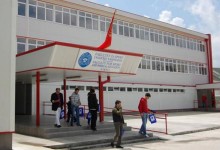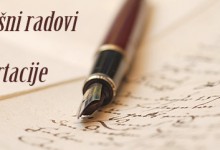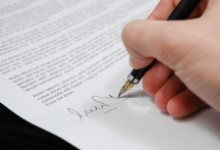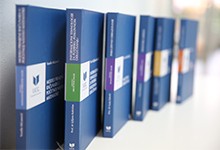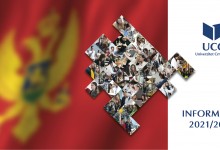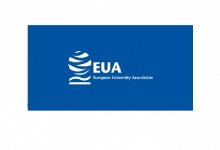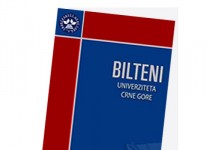Faculty for Sport and Physical Education / COLLEGE FOR SPORTS JOURNALISM / ORTHOGRAPHY AND RHETORIC
| Course: | ORTHOGRAPHY AND RHETORIC/ |
| Course ID | Course status | Semester | ECTS credits | Lessons (Lessons+Exercises+Laboratory) |
| 4027 | Obavezan | 1 | 4 | 2+1+0 |
| Programs | COLLEGE FOR SPORTS JOURNALISM |
| Prerequisites | No prerequisites required |
| Aims | Learning basic rules of spelling and speaking |
| Learning outcomes | After passing this exam, a student will be able to: 1. Define the basic concepts of speech - language, spelling and speaking skills and apply them in further study and use of language; 2. Differ basic spelling and speaking rules; the standard and nonstandard ones. 3. Apply orthoepic norm of the standard language in speech and direct work on the text; 4. Analyze and resolve issues related to checking and orthoepy; 5. Evaluate the importance of spelling and speaking skills in oral and written communication; |
| Lecturer / Teaching assistant | Miodarka Tepavčević, Ph.D. – lecturer, |
| Methodology | Lectures, doing tests, consultations and final exam |
| Plan and program of work | |
| Preparing week | Preparation and registration of the semester |
| I week lectures | Introductory remarks; definition, classification, spelling rules |
| I week exercises | |
| II week lectures | Rules for writing capital and small letters |
| II week exercises | |
| III week lectures | Abbreviations and dismantled words at end of line |
| III week exercises | |
| IV week lectures | Spelling and punctuation |
| IV week exercises | |
| V week lectures | Jointed and separate words spelling (nouns, adjectives, pronouns,numbers) Preparing for the first test |
| V week exercises | |
| VI week lectures | Jointed and separate writing words (verbs, adverbs, adjectives, prepositions lnking words exclamations) |
| VI week exercises | |
| VII week lectures | TEST 1 |
| VII week exercises | |
| VIII week lectures | Rules of the iekavian dialect |
| VIII week exercises | |
| IX week lectures | Equalization of consonants (the voicing and manner of formation) |
| IX week exercises | |
| X week lectures | Equation of consonants (the sonority and manner of formation) |
| X week exercises | |
| XI week lectures | The simplification of consonant clusters |
| XI week exercises | |
| XII week lectures | Speaking rules – ortoepia, ortoepic flaws |
| XII week exercises | |
| XIII week lectures | Preparation for the second test |
| XIII week exercises | |
| XIV week lectures | Prosodic rules (stress and duration), rules of stressing; |
| XIV week exercises | |
| XV week lectures | TEST 2 |
| XV week exercises |
| Student workload | During the semester: Lectures and final exam: 8 hours x 16 = 120 hours Necessary preparations before the start of the semester (administration, registration, certification) 2 x (8 hours) = 16 hours Total hours for the course: 6x30 = 180 hours Additional work for the preparation of the remedial final exam, including the taking the remedial final exam from 0 to 44 hours (the remaining time of the first two items to the total load of the course) Structure of the load: 120 hours (teaching) + 16 hours (preparation) + 44 hours (additional work) |
| Per week | Per semester |
| 4 credits x 40/30=5 hours and 20 minuts
2 sat(a) theoretical classes 0 sat(a) practical classes 1 excercises 2 hour(s) i 20 minuts of independent work, including consultations |
Classes and final exam:
5 hour(s) i 20 minuts x 16 =85 hour(s) i 20 minuts Necessary preparation before the beginning of the semester (administration, registration, certification): 5 hour(s) i 20 minuts x 2 =10 hour(s) i 40 minuts Total workload for the subject: 4 x 30=120 hour(s) Additional work for exam preparation in the preparing exam period, including taking the remedial exam from 0 to 30 hours (remaining time from the first two items to the total load for the item) 24 hour(s) i 0 minuts Workload structure: 85 hour(s) i 20 minuts (cources), 10 hour(s) i 40 minuts (preparation), 24 hour(s) i 0 minuts (additional work) |
| Student obligations | Students are obliged to attend the classes regularly, do the examination papers and take the final exam |
| Consultations | On Tuesdays 2 p.m |
| Literature | Pravopis srpskohrvatskog jezika, MS/MH, 1960; Pravopis srpskoga jezika, Mitar Pešikan, Jovan Jerković, Mato Pižurica, Novi Sad, 2011; Milorad Dešić, Pravopis srpskog jezika, Zemun 1998; Branislav Ostojić, Kratka pregledna gramatika srpskog jezika i pravop |
| Examination methods | 2 tests 25 points each Final exam– 50 points A student can be given passing grade if he/she collects at least 51 points. |
| Special remarks | |
| Comment |
| Grade: | F | E | D | C | B | A |
| Number of points | less than 50 points | greater than or equal to 50 points and less than 60 points | greater than or equal to 60 points and less than 70 points | greater than or equal to 70 points and less than 80 points | greater than or equal to 80 points and less than 90 points | greater than or equal to 90 points |
Faculty for Sport and Physical Education / COLLEGE FOR SPORTS JOURNALISM / THEORY OF SPORT
| Course: | THEORY OF SPORT/ |
| Course ID | Course status | Semester | ECTS credits | Lessons (Lessons+Exercises+Laboratory) |
| 1933 | Obavezan | 1 | 5 | 2+1+0 |
| Programs | COLLEGE FOR SPORTS JOURNALISM |
| Prerequisites | There are no prerequisites required for signing up for this course |
| Aims | The aim of the Theory of Sport as a course can be seen in stimulating students’ spiritual efforts to consider the very foundations of the profession they have chosen, i.e. their efforts for its further development and revision. Explaining certain morphological, practical and epistemological processes for independent professional development |
| Learning outcomes | Having passed this course, the student will be able to: 1. Represent to the public the importance of physical culture and its segments (physical education, sports recreation, and especially sport); 2. Point to and suggest the functions of sport; 3. More easily recognise and convey to the public the foundations of sport from the terminological definitions, processes in sport; 4. Recognise the characteristics of sport, forms of sport; Influence the development of the awareness of ethics in sport, i.e. politics and sport, but also of suppressing negative consequences, such as violence, vandalism |
| Lecturer / Teaching assistant | Prof.dr Duško Bjelica /195872/; Teaching assistant: Milan Jovanović |
| Methodology | Lectures, task solving, seminar papers, consultations, exams. |
| Plan and program of work | |
| Preparing week | Preparation and registration of the semester |
| I week lectures | Preparation for and enrolment on the course |
| I week exercises | |
| II week lectures | The subject, tasks and importance of the theory of sport; Scientific and practical prerequisites of the development of sport. |
| II week exercises | |
| III week lectures | The structure and development of sport; The basic characteristics of sport; Forms of sport |
| III week exercises | |
| IV week lectures | The function of sport; Classification of sports branches; Culture and physical culture |
| IV week exercises | |
| V week lectures | The basic terms and terminological delimitations; The rules, schedule and propositions of competitions |
| V week exercises | |
| VI week lectures | Factors that influence competition activities of athletes |
| VI week exercises | |
| VII week lectures | Mid-term exam |
| VII week exercises | |
| VIII week lectures | Sport as a form of physical culture; Ethics in sport; Dualism of ethics in sport; An athlete as a personality |
| VIII week exercises | |
| IX week lectures | efinition and the basic characteristics of the game; The functions of the game |
| IX week exercises | |
| X week lectures | Classification of games; Game as a form of physical culture; Moral aspects of doping. |
| X week exercises | |
| XI week lectures | Classification of sport; The school, registered, recreational, amateur, professional and top sport |
| XI week exercises | |
| XII week lectures | Sport and politics; Violence in sport; Sports vandalism; Violence against young people |
| XII week exercises | |
| XIII week lectures | Sports equipment; Factors in sport The regulation and organisation of competitions |
| XIII week exercises | |
| XIV week lectures | Second exam |
| XIV week exercises | |
| XV week lectures | Final exam |
| XV week exercises |
| Student workload | Weekly: 5 credits x 40/30 = 6 hours Structure of the workload: 4 hours of theoretical lectures 2 hours and 40 minutes of independent work, including consultations During the semester: Lectures and final exam: 6,40 x 16= 106 hours and 40 minutes Necessary preparations before the start of the semester (administration, registration, certification) 2 x (6 hours 40 minutes) = 13 hours and 20 minutes Total hours for the course: 5 x 30 = 150 hours Additional work for the preparation of the makeup final exam, including taking the makeup final exam from 0 to 30 hours Structure of the workload: 106,40 hours (teaching) + 8 hours (preparation) + 30 hours (additional work) |
| Per week | Per semester |
| 5 credits x 40/30=6 hours and 40 minuts
2 sat(a) theoretical classes 0 sat(a) practical classes 1 excercises 3 hour(s) i 40 minuts of independent work, including consultations |
Classes and final exam:
6 hour(s) i 40 minuts x 16 =106 hour(s) i 40 minuts Necessary preparation before the beginning of the semester (administration, registration, certification): 6 hour(s) i 40 minuts x 2 =13 hour(s) i 20 minuts Total workload for the subject: 5 x 30=150 hour(s) Additional work for exam preparation in the preparing exam period, including taking the remedial exam from 0 to 30 hours (remaining time from the first two items to the total load for the item) 30 hour(s) i 0 minuts Workload structure: 106 hour(s) i 40 minuts (cources), 13 hour(s) i 20 minuts (preparation), 30 hour(s) i 0 minuts (additional work) |
| Student obligations | Students are obliged to attend the lectures, actively participate in the theoretical and practical classes and exercises, and do two exams. |
| Consultations | |
| Literature | Bjelica, D. (2005). Teorija sporta. Skripta. Fakultet za sport i fizičko vaspitanje Nikšić.; Mašić, Z., Đukanović, N. (2008). Teorija sporta. Medicinska akademija US Medical School. Beograd.; Živanović, N. Teorija sporta, Niš.; Tomić, D. Teorija sporta. B |
| Examination methods | Two exams 22 points each (44 in total). Seminar papers 6 points. Final exam: 50 points. The passing grade is achieved if the student cumulatively earns 51 points and regularly attends the classes. |
| Special remarks | : Exercises are organised for a group up to 20 students |
| Comment | none |
| Grade: | F | E | D | C | B | A |
| Number of points | less than 50 points | greater than or equal to 50 points and less than 60 points | greater than or equal to 60 points and less than 70 points | greater than or equal to 70 points and less than 80 points | greater than or equal to 80 points and less than 90 points | greater than or equal to 90 points |
Faculty for Sport and Physical Education / COLLEGE FOR SPORTS JOURNALISM / FUNCTIONAL STYLES OF PUBLISHING AND JOURNALISM
| Course: | FUNCTIONAL STYLES OF PUBLISHING AND JOURNALISM/ |
| Course ID | Course status | Semester | ECTS credits | Lessons (Lessons+Exercises+Laboratory) |
| 4033 | Obavezan | 2 | 4 | 2+0+0 |
| Programs | COLLEGE FOR SPORTS JOURNALISM |
| Prerequisites | No prerequisites required |
| Aims | Acquisition of the characteristics of functional styles, especially the non-fiction-journalistic one. |
| Learning outcomes | After passing this exam a student will be able to: 1. describe the main types of linguistic stratification; 2. expose the general characteristics of functional styles; 3. clarify the rules of the structuring of functional styles and genres; 4. develop positive qualities of fictional and journalistic style; 5. apply the acquired knowledge in the communications practice. |
| Lecturer / Teaching assistant | Sonja Nenezić, Ph.D |
| Methodology | Lectures, mid-term examination papers, consultations and final exam |
| Plan and program of work | |
| Preparing week | Preparation and registration of the semester |
| I week lectures | Information about the subject, literature and forms of testing |
| I week exercises | |
| II week lectures | Stratification of languages: territorial, social and individual stratification |
| II week exercises | |
| III week lectures | The functional stratification of the language |
| III week exercises | |
| IV week lectures | Literary style and its linguistic features |
| IV week exercises | |
| V week lectures | Scientific style and its linguistic features |
| V week exercises | |
| VI week lectures | Administrative and legal style and its linguistic features |
| VI week exercises | |
| VII week lectures | Mid-term examination paper 1 |
| VII week exercises | |
| VIII week lectures | Conversational style and its linguistic features |
| VIII week exercises | |
| IX week lectures | Publicist-journalist style |
| IX week exercises | |
| X week lectures | The linguistic features of publicist and journalistic style |
| X week exercises | |
| XI week lectures | Nominalization of linguistic expression. |
| XI week exercises | |
| XII week lectures | Decomposition of predicate |
| XII week exercises | |
| XIII week lectures | The newspaper phraseology |
| XIII week exercises | |
| XIV week lectures | The bureaucratization of a language |
| XIV week exercises | |
| XV week lectures | Mid-term examination paper 2 |
| XV week exercises |
| Student workload | During the semester: Lectures and final exam: 16 x 6 h 35 minutes = 85 hours 5 minutes Necessary preparations: befoe the semester (administration, enrollment, verfication) 2 x 5 hours 20 minutes = 10 hours 40 minutes Total class load: 4 x 30 = 120 hours Additional work for preparation of the exam in the additional term: 30 hours 50 minutes. Structure of the load: 85 hours 5 minutes (lectures) + 10 h 40 minutes (preparation) + 24h 15 min. (additional work) = 120 hours |
| Per week | Per semester |
| 4 credits x 40/30=5 hours and 20 minuts
2 sat(a) theoretical classes 0 sat(a) practical classes 0 excercises 3 hour(s) i 20 minuts of independent work, including consultations |
Classes and final exam:
5 hour(s) i 20 minuts x 16 =85 hour(s) i 20 minuts Necessary preparation before the beginning of the semester (administration, registration, certification): 5 hour(s) i 20 minuts x 2 =10 hour(s) i 40 minuts Total workload for the subject: 4 x 30=120 hour(s) Additional work for exam preparation in the preparing exam period, including taking the remedial exam from 0 to 30 hours (remaining time from the first two items to the total load for the item) 24 hour(s) i 0 minuts Workload structure: 85 hour(s) i 20 minuts (cources), 10 hour(s) i 40 minuts (preparation), 24 hour(s) i 0 minuts (additional work) |
| Student obligations | Students are obliged to attend the classes regularly, do the mid-term papers and take the final exam. |
| Consultations | tuesdays 11 i 30 ‒ 12 i 30 h |
| Literature | Branko Tošović, Funkcionalni stilovi, Graz, 2002; Milorad Radovanović, Sociolingvistika, Novi Sad, 1986; Vladislava Petrović, Novinska frazeologija, Novi Sad, 1989. |
| Examination methods | 2 mid-term papers 25 points each, final examination 50 points. Passing grade can be given if a student collects at least 50 points. |
| Special remarks | |
| Comment |
| Grade: | F | E | D | C | B | A |
| Number of points | less than 50 points | greater than or equal to 50 points and less than 60 points | greater than or equal to 60 points and less than 70 points | greater than or equal to 70 points and less than 80 points | greater than or equal to 80 points and less than 90 points | greater than or equal to 90 points |
Faculty for Sport and Physical Education / COLLEGE FOR SPORTS JOURNALISM / SPORTS COMMUNICATION
| Course: | SPORTS COMMUNICATION/ |
| Course ID | Course status | Semester | ECTS credits | Lessons (Lessons+Exercises+Laboratory) |
| 4643 | Obavezan | 2 | 4 | 2+1+0 |
| Programs | COLLEGE FOR SPORTS JOURNALISM |
| Prerequisites | There are no prerequisites required for signing up for this course |
| Aims | : The aim of the course is the analysis of issues related to sports communications that encompass: information, its subject, place of origin with its structure and functions of creating, the direction of transmitting information and the place of its use, as well as its very use, and the results that subsequently come out of this process. This means acquainting students with the system of communication. |
| Learning outcomes | Having passed this course, the student will be able to: 1. Explain the essence and importance of communication realised in sport and in relation to sport 2. Analyse the elements of communicating in sport 3. Understand the ways of information exchange between sports partners 4. Recognise the basic functions of sports media 5. Describe the importance of methods of scientific research in the process of sports communic |
| Lecturer / Teaching assistant | Prof.dr Duško Bjelica, dr Aldijana Muratović |
| Methodology | Lectures, debates, exercises, seminar papers, consultations, exams. |
| Plan and program of work | |
| Preparing week | Preparation and registration of the semester |
| I week lectures | Communication in sport |
| I week exercises | Communication in sport |
| II week lectures | General definition of communication in sport |
| II week exercises | General definition of communication in sport |
| III week lectures | Theoretical foundations of sports communication |
| III week exercises | Theoretical foundations of sports communication |
| IV week lectures | Determinants of communication in sport |
| IV week exercises | Determinants of communication in sport |
| V week lectures | Preparation for the exam in the form of writing and dialogue |
| V week exercises | Preparation for the exam in the form of writing and dialogue |
| VI week lectures | Mid-term exam |
| VI week exercises | |
| VII week lectures | The structure of communication in sport |
| VII week exercises | The structure of communication in sport |
| VIII week lectures | Mass media in sports communication |
| VIII week exercises | Mass media in sports communication |
| IX week lectures | Sports propaganda |
| IX week exercises | Sports propaganda |
| X week lectures | Creating a test with short answers on multiple questions |
| X week exercises | Creating a test with short answers on multiple questions |
| XI week lectures | Methodological foundations of sports communication |
| XI week exercises | Methodological foundations of sports communication |
| XII week lectures | Second exam |
| XII week exercises | |
| XIII week lectures | Creating a test with short answers on multiple questions |
| XIII week exercises | Creating a test with short answers on multiple questions |
| XIV week lectures | The phase of projecting the communication system in sport; Methods of communication |
| XIV week exercises | The phase of projecting the communication system in sport; Methods of communication |
| XV week lectures | Final exam |
| XV week exercises |
| Student workload | Weekly: 4 credits x 40/30 = 5 hours and 30 minutes Structure: 2 hours of lectures 1 hour of practical lectures 2 hours of independent work, including consultations During the semester: Lectures and final exam: 5,30 x 16= 85 hours Necessary preparations before the start of the semester (administration, registration, certification) 2 x (5 hours 30 minutes) = 11 hours Total hours for the course: 4 x 30 = 150 hours Additional work for the preparation of the makeup final exam, including taking the makeup final exam from 0 to 30 hours Structure of the workload: 85 hours (teaching) + 11 hours (preparation) + 24 hours (additional work |
| Per week | Per semester |
| 4 credits x 40/30=5 hours and 20 minuts
2 sat(a) theoretical classes 0 sat(a) practical classes 1 excercises 2 hour(s) i 20 minuts of independent work, including consultations |
Classes and final exam:
5 hour(s) i 20 minuts x 16 =85 hour(s) i 20 minuts Necessary preparation before the beginning of the semester (administration, registration, certification): 5 hour(s) i 20 minuts x 2 =10 hour(s) i 40 minuts Total workload for the subject: 4 x 30=120 hour(s) Additional work for exam preparation in the preparing exam period, including taking the remedial exam from 0 to 30 hours (remaining time from the first two items to the total load for the item) 24 hour(s) i 0 minuts Workload structure: 85 hour(s) i 20 minuts (cources), 10 hour(s) i 40 minuts (preparation), 24 hour(s) i 0 minuts (additional work) |
| Student obligations | : Students are obliged to attend the lectures, do assigned topics, take 2 exams, do exercises |
| Consultations | monday,10:00 |
| Literature | : Bjelica, D. (2012). Komunikacije u sportu. Fakultet za sport i fizičko vaspitanje-Nikšić; Bjelica, S., D. Bjelica (2006). Komunikacije u sportu. Filozofski fakultet-Nikšić |
| Examination methods | Two exams 22 points each. Seminar paper up to 6 points. Final exam: 50 points The passing grade is achieved if the student cumulatively earns 51 points and regularly attends the classes |
| Special remarks | none |
| Comment | none |
| Grade: | F | E | D | C | B | A |
| Number of points | less than 50 points | greater than or equal to 50 points and less than 60 points | greater than or equal to 60 points and less than 70 points | greater than or equal to 70 points and less than 80 points | greater than or equal to 80 points and less than 90 points | greater than or equal to 90 points |
Faculty for Sport and Physical Education / COLLEGE FOR SPORTS JOURNALISM / BASIC THEORY OF SPORTS TRAINING
| Course: | BASIC THEORY OF SPORTS TRAINING/ |
| Course ID | Course status | Semester | ECTS credits | Lessons (Lessons+Exercises+Laboratory) |
| 4039 | Obavezan | 2 | 5 | 2+1+0 |
| Programs | COLLEGE FOR SPORTS JOURNALISM |
| Prerequisites | Prerequisites: There are no prerequisites required for signing up for this course |
| Aims | Course objectives: The aim of the course is to acquaint students with the sports training which is a multidisciplinary science, based on a series of important scientific disciplines, so that the students can more easily understand sport as a whole and certain independent sports through the preparation for competitions. |
| Learning outcomes | Having passed this course, the student will be able to: 1. Explain development phases of sport through history 2. Describe the training and learning methods in the process of sports training 3. Define elementary biomotor dimensions 4. Recognise the human, biological, and pedagogical importance of sport 5. Explain prohibited substances and prohibited methods in sport 6. Analyse the structure of personality from the psychological perspective |
| Lecturer / Teaching assistant | Prof.dr Duško Bjelica, dr Aldijana Muratović |
| Methodology | Teaching methods: Lectures, debates, exercises, seminar papers, consultations, exams. |
| Plan and program of work | |
| Preparing week | Preparation and registration of the semester |
| I week lectures | The notion of sport; Technique; Training |
| I week exercises | |
| II week lectures | Training; Strategy and tactics |
| II week exercises | |
| III week lectures | Basic scientific disciplines of sports training |
| III week exercises | |
| IV week lectures | Systematisation of sports |
| IV week exercises | |
| V week lectures | The notion of systematisation and categorisation of sports disciplines |
| V week exercises | |
| VI week lectures | Mid-term exam |
| VI week exercises | |
| VII week lectures | Psychological foundations of sports training; the structure of personality |
| VII week exercises | |
| VIII week lectures | Psychosocial dynamic of sports groups |
| VIII week exercises | |
| IX week lectures | Learning methods in sports training |
| IX week exercises | |
| X week lectures | Pedagogical foundations of sports training; Didactic principles |
| X week exercises | |
| XI week lectures | Planning and programming of sports training |
| XI week exercises | |
| XII week lectures | Cycles in sports training |
| XII week exercises | |
| XIII week lectures | Second exam |
| XIII week exercises | |
| XIV week lectures | Doping |
| XIV week exercises | |
| XV week lectures | Final exam |
| XV week exercises |
| Student workload | Student workload: Weekly: 5credits x 40/30 = 6 hours 40 min. Structure: 3 hours of lectures 3 hours 40 min. of independent work, including consultations During the semester: Lectures and final exam: 6,40 x 16= 106 hours 40 min. Necessary preparations before the start of the semester (administration, registration, certification) 2 x (6 hours 40 minutes) = 13 hours 20 min. Total hours for the course: 5 x 30 = 150 hours Additional work for the preparation of the makeup final exam, including taking the makeup final exam from 0 to 30 hours Structure of the workload: 106 hours 40 min. (teaching) + 13 hours 20 min. (preparation) + 30 hours (additional work) |
| Per week | Per semester |
| 5 credits x 40/30=6 hours and 40 minuts
2 sat(a) theoretical classes 0 sat(a) practical classes 1 excercises 3 hour(s) i 40 minuts of independent work, including consultations |
Classes and final exam:
6 hour(s) i 40 minuts x 16 =106 hour(s) i 40 minuts Necessary preparation before the beginning of the semester (administration, registration, certification): 6 hour(s) i 40 minuts x 2 =13 hour(s) i 20 minuts Total workload for the subject: 5 x 30=150 hour(s) Additional work for exam preparation in the preparing exam period, including taking the remedial exam from 0 to 30 hours (remaining time from the first two items to the total load for the item) 30 hour(s) i 0 minuts Workload structure: 106 hour(s) i 40 minuts (cources), 13 hour(s) i 20 minuts (preparation), 30 hour(s) i 0 minuts (additional work) |
| Student obligations | Requirements for students: Students are obliged to attend the lectures, do assigned topics, take 2 exams, do exercises |
| Consultations | Consultations |
| Literature | Literature: Bjelica,D.’’Sportski trening i sistematizacija sportskih disciplina’’,Pg.2005.Bjelica,D.’’Sportski trening’’. Pgd.2006.’’Epistemiologija fizičke kulture’’,N.Živanović,Niš,2000.g’’Komunikacije u sportu’’,S.Bjelica, D.Bjelica, 2006.; "Sports |
| Examination methods | Forms of assessment: Two exams 22 points each. Seminar paper up to 6 points. Final exam: 50 points The passing grade is achieved if the student cumulatively earns 51 points and regularly attends the classes. MARKS: E 51 – 60; D 61 – 70 ; C 71 |
| Special remarks | None |
| Comment | None |
| Grade: | F | E | D | C | B | A |
| Number of points | less than 50 points | greater than or equal to 50 points and less than 60 points | greater than or equal to 60 points and less than 70 points | greater than or equal to 70 points and less than 80 points | greater than or equal to 80 points and less than 90 points | greater than or equal to 90 points |
Faculty for Sport and Physical Education / COLLEGE FOR SPORTS JOURNALISM / ENGLISH LANGUAGE III
| Course: | ENGLISH LANGUAGE III/ |
| Course ID | Course status | Semester | ECTS credits | Lessons (Lessons+Exercises+Laboratory) |
| 6427 | Obavezan | 3 | 3 | 2+0+0 |
| Programs | COLLEGE FOR SPORTS JOURNALISM |
| Prerequisites | There are no pre-conditions for the attendance of this course |
| Aims | Acquisition of speech and writing comprehension competences, acquisition of oral and written competencies in English, improving and upgrading the level of English language grammar knowledge |
| Learning outcomes | After passing the final exam, it is expected that the student will be able to: 1. Correctly use the Present Simple, Past Simple and Future Tense in positive, negative and interrogative form. 2. Show the correct use of Modal verbs in written as well as in oral form, recognise and correct the mistakes. 3. Form sentences and talk about different topics (favourite sport, free time, leisure activities) 4. Write short, narrative essays using different linking words, adverb phrases and co-ordinating conjunctions to connect the sentences. 5. Translate from and into English simple and compound sentences. |
| Lecturer / Teaching assistant | mr Dedović Dragana |
| Methodology | Lectures, language exercises, consultations, translation, discussions, homework |
| Plan and program of work | |
| Preparing week | Preparation and registration of the semester |
| I week lectures | Introductory lesson, preparation and enrollment into the course |
| I week exercises | |
| II week lectures | Reading and translating ’Wonders of modern world’, discussion (the most important invention). |
| II week exercises | |
| III week lectures | Correcting mistakes in an informal letter, symbols for correction. |
| III week exercises | |
| IV week lectures | Auxiliary verbs, questions and negatives, short answers. |
| IV week exercises | |
| V week lectures | Reading and translating ’The writer, the painter and the musician’. |
| V week exercises | |
| VI week lectures | Writing a narrative, past tenses, giving opinions. |
| VI week exercises | |
| VII week lectures | Discussion – sports activities and leisure time. |
| VII week exercises | |
| VIII week lectures | Colloquium I |
| VIII week exercises | |
| IX week lectures | Reading and translating ‘A world guide to good manners’, filling a form. |
| IX week exercises | |
| X week lectures | Future tenses, modal verbs. |
| X week exercises | |
| XI week lectures | Discussion – weather, public transport; sending a fax. |
| XI week exercises | |
| XII week lectures | Reading and translating ’In search of good English food’, descriptive writing. |
| XII week exercises | |
| XIII week lectures | Colloquium II |
| XIII week exercises | |
| XIV week lectures | General revision and preparation for final exam |
| XIV week exercises | |
| XV week lectures | Final exam |
| XV week exercises |
| Student workload | During the semester: Lectures and final exam: 8 hours x 16 = 120 hours Necessary preparations before the start of the semester (administration, registration, certification) 2 x (8 hours) = 16 hours Total hours for the course: 6x30 = 180 hours Additional work for the preparation of make-up final exam, including the time for taking the make-up final exam from 0 to 44 hours (the remaining time of the first two items to the total load of the course) Structure of the load: 120 hours (teaching) + 16 hours (preparation) + 44 hours (additional work) |
| Per week | Per semester |
| 3 credits x 40/30=4 hours and 0 minuts
2 sat(a) theoretical classes 0 sat(a) practical classes 0 excercises 2 hour(s) i 0 minuts of independent work, including consultations |
Classes and final exam:
4 hour(s) i 0 minuts x 16 =64 hour(s) i 0 minuts Necessary preparation before the beginning of the semester (administration, registration, certification): 4 hour(s) i 0 minuts x 2 =8 hour(s) i 0 minuts Total workload for the subject: 3 x 30=90 hour(s) Additional work for exam preparation in the preparing exam period, including taking the remedial exam from 0 to 30 hours (remaining time from the first two items to the total load for the item) 18 hour(s) i 0 minuts Workload structure: 64 hour(s) i 0 minuts (cources), 8 hour(s) i 0 minuts (preparation), 18 hour(s) i 0 minuts (additional work) |
| Student obligations | Students are expected to regularly attend lectures and actively participate in classes. |
| Consultations | Tuesday 10:00 – 11:30 |
| Literature | John and Liz Soars: New Headway English Course (Intermediate), Student`s Book, Oxford University Press, Oxford, 2003. John and Liz Soars: New Headway English Course (Intermediate), Workbook, Oxford University Press, Oxford, 2003. John Eastwood: Oxford Gui |
| Examination methods | Grading is structured within the scale 0-100% of the mastered material, while the passing grade will be achieved with the accumulation of 51% of the total material, as follows: attendance – 3 points, two tests – 20 points each, essay 5 points, homework 2 |
| Special remarks | |
| Comment | Lectures are held in English and mother tongue |
| Grade: | F | E | D | C | B | A |
| Number of points | less than 50 points | greater than or equal to 50 points and less than 60 points | greater than or equal to 60 points and less than 70 points | greater than or equal to 70 points and less than 80 points | greater than or equal to 80 points and less than 90 points | greater than or equal to 90 points |
Faculty for Sport and Physical Education / COLLEGE FOR SPORTS JOURNALISM / THEORY AND RULES OF BASKETBALL
| Course: | THEORY AND RULES OF BASKETBALL/ |
| Course ID | Course status | Semester | ECTS credits | Lessons (Lessons+Exercises+Laboratory) |
| 4648 | Obavezan | 3 | 5 | 2+0+0 |
| Programs | COLLEGE FOR SPORTS JOURNALISM |
| Prerequisites | There are no prerequisites required for signing up for this course |
| Aims | Acquainting students with the development, theoretical foundations and rules of basketball so that the acquired knowledge could be successfully applied in journalistic work. |
| Learning outcomes | Having passed this course, the student will be able to: 1. Analyse and explain technical elements in basketball 2. Analyse and explain competition rules in basketball 3. Follow and explain the course of match and certain actions in the game 4. Analyse and explain officiating signs during the match 5. Follow the course of match by statistical indicators 6. Keep a score book of a basketball match |
| Lecturer / Teaching assistant | Prof.dr Rašid Hadžić |
| Methodology | Theoretical lectures, seminar papers, consultations, exams, and the final exam |
| Plan and program of work | |
| Preparing week | Preparation and registration of the semester |
| I week lectures | Origins and historical development of basketball. |
| I week exercises | |
| II week lectures | Basic characteristics of basketball. |
| II week exercises | |
| III week lectures | Anthropological features of basketball. |
| III week exercises | |
| IV week lectures | The equation of success specification in basketball by playing positions. |
| IV week exercises | |
| V week lectures | Systematisation and analysis of basketball technique elements. |
| V week exercises | |
| VI week lectures | Mid-term exam |
| VI week exercises | |
| VII week lectures | Basketball federations, associations and organisation of competitions. |
| VII week exercises | |
| VIII week lectures | Basketball objects, participants and equipment. |
| VIII week exercises | |
| IX week lectures | Organisation of a match. The course of a match: game actions. |
| IX week exercises | |
| X week lectures | Rules of basketball (with comments and instructions). |
| X week exercises | |
| XI week lectures | Referees and officiating signs. |
| XI week exercises | |
| XII week lectures | Second exam |
| XII week exercises | |
| XIII week lectures | Keeping an international score book. |
| XIII week exercises | |
| XIV week lectures | Following a match by statistical indicators |
| XIV week exercises | |
| XV week lectures | Criteria for the selection of the player of the match, round, championship; the selection of the team of the round, championship |
| XV week exercises |
| Student workload | During the semester: Lectures and final exam: 6,40 x 16= 106,40 hours Necessary preparations before the start of the semester (administration, registration, certification) 2 x (6 hours 40 minutes) = 13 hours 20 min. Total hours for the course: 5 x 30 = 150 hours Additional work for the preparation of the makeup final exam, including taking the makeup final exam from 0 to 30 hours. Structure of the workload: 106,40 hours (teaching) + 13 hours 20 min. (preparation) + 30 hours (additional work) |
| Per week | Per semester |
| 5 credits x 40/30=6 hours and 40 minuts
2 sat(a) theoretical classes 0 sat(a) practical classes 0 excercises 4 hour(s) i 40 minuts of independent work, including consultations |
Classes and final exam:
6 hour(s) i 40 minuts x 16 =106 hour(s) i 40 minuts Necessary preparation before the beginning of the semester (administration, registration, certification): 6 hour(s) i 40 minuts x 2 =13 hour(s) i 20 minuts Total workload for the subject: 5 x 30=150 hour(s) Additional work for exam preparation in the preparing exam period, including taking the remedial exam from 0 to 30 hours (remaining time from the first two items to the total load for the item) 30 hour(s) i 0 minuts Workload structure: 106 hour(s) i 40 minuts (cources), 13 hour(s) i 20 minuts (preparation), 30 hour(s) i 0 minuts (additional work) |
| Student obligations | Students are obliged to attend the lectures, do exams, write seminar papers and do the final exam. |
| Consultations | On Tuesdays at 10 am |
| Literature | Karalejić, M.: Osnove košarke, Beograd, 2001 Rubin P. (1998). Košarka – metodika i tehnika, Novi Sad. Trninić, S.: Analiza učenja košarkaške igre, Pula, 1996 KSCG: Pravila košarke, 2012 |
| Examination methods | Attendance in theoretical classes 5 points; - Participation 5 points; - Two exams 15 points each; - Seminar paper 10 points; - Final exam 50 points The passing grade is achieved if the student cumulatively earns 51 points and reg |
| Special remarks | |
| Comment | The realisation plan for the teaching programme will be handed out to students at the beginning of the semester. |
| Grade: | F | E | D | C | B | A |
| Number of points | less than 50 points | greater than or equal to 50 points and less than 60 points | greater than or equal to 60 points and less than 70 points | greater than or equal to 70 points and less than 80 points | greater than or equal to 80 points and less than 90 points | greater than or equal to 90 points |
Faculty for Sport and Physical Education / COLLEGE FOR SPORTS JOURNALISM / MASS-MEDIA LANGUAGE
| Course: | MASS-MEDIA LANGUAGE/ |
| Course ID | Course status | Semester | ECTS credits | Lessons (Lessons+Exercises+Laboratory) |
| 4650 | Obavezan | 4 | 3 | 2+0+0 |
| Programs | COLLEGE FOR SPORTS JOURNALISM |
| Prerequisites | None |
| Aims | The subject is aimed at preparing students for the proper and effective use of language in mass media.Approval of theories and practices, primarily informative journalism, in which prevail standardized linguistic norms, because the language has remained the essence of journalism and mass media |
| Learning outcomes | After passing this exam, students will be able to explain the basic concepts of information theory and communication, language and culture of speech. It differs folk, literary and standard language, as well as the literary, artistic, journalistic, scientific, administrative and conversational stl. Compare the traditional observation of literacy and modern functional linguistic, reading literacy. Uses and builds literacy and journalistic stil.Explain journalistic genres: informative, analytical, fictional and uses the language of the mass media - traditional and electronic. |
| Lecturer / Teaching assistant | Doc.dr Velizar Sredanovic |
| Methodology | teach,tests,writing eseys,seminars,conversation |
| Plan and program of work | |
| Preparing week | Preparation and registration of the semester |
| I week lectures | Introductory predavanje.Theories information and komunikacija.Komuniciranje.Jezik and mass media. |
| I week exercises | |
| II week lectures | Language and stil.Shapes izražvanja.Masmediji: press, radio, television, newspaper agencije.film .... |
| II week exercises | |
| III week lectures | The message and the method of forming poruka.Oblici journalistic expression. |
| III week exercises | |
| IV week lectures | Information (factual) and commentary analysis forms of journalistic expression. |
| IV week exercises | |
| V week lectures | Fiction (literary) forms of journalistic expression |
| V week exercises | |
| VI week lectures | Humorous-satirical kind. Newspaper critics |
| VI week exercises | |
| VII week lectures | First test (Writing essays) |
| VII week exercises | |
| VIII week lectures | Problems checking in writing media.Shapes and meanings of words. |
| VIII week exercises | |
| IX week lectures | Definitions and role of vocabulary in the media. |
| IX week exercises | |
| X week lectures | Spoken language in the media. From phonetics. |
| X week exercises | |
| XI week lectures | Language and television.Shaping text and editing of literature, theater, film, visual arts and music in the media. |
| XI week exercises | |
| XII week lectures | A media literacy and competence. |
| XII week exercises | |
| XIII week lectures | Second test (Knowledge Test) |
| XIII week exercises | |
| XIV week lectures | Seminar. The role and importance of proofreaders and editors in journalism - the media. |
| XIV week exercises | |
| XV week lectures | Final exam |
| XV week exercises |
| Student workload | During the semester: Lectures and final exam: 4 hours x 16 = 60 hours Necessary preparations before the start of the semester (administration, registration, certification) 2 x (4 hours) = 8 hours Total hours for the course: 3x30 = 90 hours Additional work for the preparation of the remedial final exam, including the taking the remedial final exam from 0 to 22 hours (the remaining time of the first two items to the total load of the course) Structure of the load: 60 hours (teaching) + 8 hours (preparation) + 22 hours (additional work) |
| Per week | Per semester |
| 3 credits x 40/30=4 hours and 0 minuts
2 sat(a) theoretical classes 0 sat(a) practical classes 0 excercises 2 hour(s) i 0 minuts of independent work, including consultations |
Classes and final exam:
4 hour(s) i 0 minuts x 16 =64 hour(s) i 0 minuts Necessary preparation before the beginning of the semester (administration, registration, certification): 4 hour(s) i 0 minuts x 2 =8 hour(s) i 0 minuts Total workload for the subject: 3 x 30=90 hour(s) Additional work for exam preparation in the preparing exam period, including taking the remedial exam from 0 to 30 hours (remaining time from the first two items to the total load for the item) 18 hour(s) i 0 minuts Workload structure: 64 hour(s) i 0 minuts (cources), 8 hour(s) i 0 minuts (preparation), 18 hour(s) i 0 minuts (additional work) |
| Student obligations | Students are required to attend lectures,do the tests and seminars |
| Consultations | After the lecture,when creating seminars and if it is necessary additional |
| Literature | Milan Sipka, Culture Speech, Language Institute in Sarajevo 2005th Andrew Bojd.Novinarstvo in the electronic media, Clio, Belgrade, 2002; Stefan Rus Mol, Ana Zagorac Keršer Yugoslavia, Journalism, Clio, Belgrade 2005th Velizar Sredanović, public and th |
| Examination methods | First test (written work on time) - 20 points;Second test (knowledge test) - 20 points;Seminar - 5 points;Presence and highlight during the teaching process - 5 points; Final exam - 50 points;Passing grade at least 51 points |
| Special remarks | |
| Comment | The specification of the program students will receive during classes and consultations |
| Grade: | F | E | D | C | B | A |
| Number of points | less than 50 points | greater than or equal to 50 points and less than 60 points | greater than or equal to 60 points and less than 70 points | greater than or equal to 70 points and less than 80 points | greater than or equal to 80 points and less than 90 points | greater than or equal to 90 points |




